One
The weeds are out of control. I’m making an evening effort to wade through the hoop house. Locating the plants I planted among the plants that planted themselves. The sharp smell of motherwort sieves through the air as I apologize for yanking it out. But really there are so many of you outside, why do you need to grow in here with my chili peppers?
Our smaller dog Elsie suddenly makes a sound I’ve never heard before… yipe and yip yip yip.
I’m out the door before I know I’m moving. Trying not to run when I see a black object catapult into a tree.
Two
My mother lifts each of us to the window so we can see. The bear is so large it has the trash can between its legs, like a child with a bucket of Halloween candy, sorting out what it wants to eat first.
Apparently baby shit is quite delish.
Three
In Bear: Myth, Animal, Icon, Wolf D. Storl notes that many indigenous peoples of the north tell stories of bears being a tribe of humans that chose to stay in the woods. Those northern indigenous folk knew that a skinned female bear looked alarmingly human because they often developed only two teats. More proof that those bears are the Forest People. Other stories say bears gave birth to berserkers.
Dear Mr. Storl, are you a descendant of this tribe? You certainly look more like a bear than a wolf.
Four
I’m living at a community farm with aged anti-nuke activists in the middle of nowhere Wisconsin. I live in a straw bale house with a solar panel and composting toilet. I chop wood and carry water. And then check my email.
Several herb students come my way to complete summer internships. Part of the program is to find a plant they feel drawn to and spend some time learning about it. A student says:
“Sometimes I feel like my heart is racing and I can’t breathe. What plant should I look for?”
“Let’s find some motherwort, it calms the nerves and slows the heart rate. The Latin name means something like “the lion’s tail of the heart.” I think of it as lion-hearted, like a mother bear that will rip through anything to protect a cub.”
“Wow, so weird you just mentioned bears. I had a dream last night that I had to make a soup. As I was stirring the soup I looked down into the pot and saw it was bear soup.”
Suddenly, the ferns in the woods at one end of the garden shake back and forth and a black form emerges. Takes a look at us. Not a threat. Crosses the garden and back into the woods.
One
The canine sharks circle the tree screaming alarm.
I try to grab Elsie who, for a moment, looks ready to bite me. Oh, it’s you.
I look up at the black thing to see a young bear, only ten feet up, balanced tippy toes on a branch. Oh heavens, what are those yippy things?
I smell its musky odor mixed with the sharp tang of fear.
This is the moment when Charles enters the scene in socked feet.
He grabs the leashes. Somehow a walk outranks an overgrown squirrel in the big dog’s mind. MalyBrat is quickly lured into the car.
Little dog, Elsie? Nope.
You guys you guys you guys big squirrel big squirrel big squirrel!!!
Two
I’m walking home in the dark streets of the ski town I grew up in. Walking because I’m too young to drive.
Many of the houses are vacant. There are no street lights once I pass DiCarli’s Market. Two blocks and I can’t see the end of my nose except when I walk past the occasional cabin with a porch light on.
I try not to think of that bear with its legs wrapped around the trash can.
Three
Bears often seek out specific foods when they first emerge from their winter slumber. Ancient humans saw bears pick the same plants over and over and realized that these plants have similar qualities. They called them bear medicine.
Bears crave aromatic and diffusive roots that stimulate digestion, respiration, and the metabolism, warming up tissues that have been resting all winter long. And then they look for berries.
Because, you know, bearies.
Four
Still in nowhere Wisconsin. I slowly ride my bike down the long dirt driveway. Once I hit the pavement, I pump my legs faster and faster. Leaning into the curve…
Suddenly I am nearly sideways from hitting the brakes so hard.
Three very large bears, single file, crossing the road.
I freeze watching, my heart thundering in my chest.
They look at me nonchalantly. Give me a nod. Hey, what’s up?
They lumber on. Going fishing.
One
Finally, I catch hold of Elsie. She nearly bites me this time not realizing it’s me. I toss her in the car where MalyBrat is waiting for his walk. When I had my back turned the bear vanished and instead three police cars materialize out of nowhere.
They get out, hitch up their pants, put on their hats, square their shoulders.
“Someone called 911. They said they saw a bear.”
“It wasn’t me.”
“No, it was the neighbors down the road. They thought it was heading this way. Did you see a bear?”
“Oh yeah, but it’s gone now.”
Their faces fall, like overgrown children in police costumes who got a trick instead of a treat.
The format for this episode of Flower Power was inspired by a writing challenge from my old friend Paul Corman, The Chapbook Whisperer hearkening back to my days in San Francisco at the New College of California. The writing challenge was started by a group of writers called the Caravan Writers Collective where you can read more bear stories. Thanks, Paul for the provocation. Strangely, the photo of the bear in our woods was taken the same day that Paul posted his story Four Bearing. Subscribe here for more flower power.
Back to our regularly scheduled program…
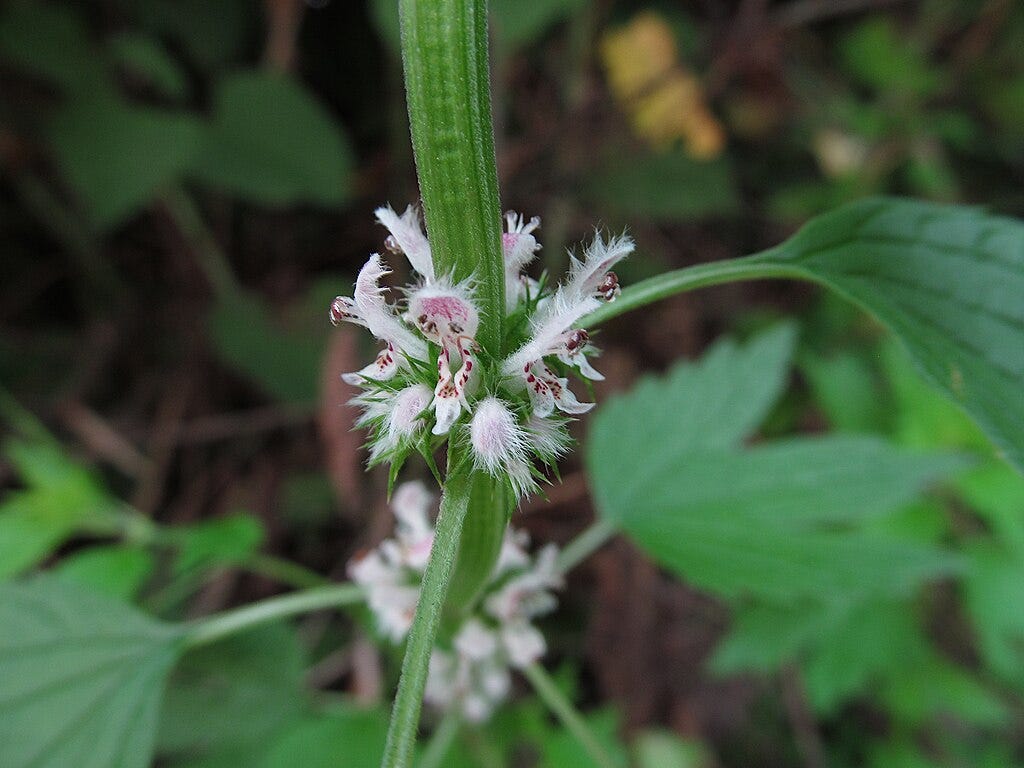
Flower Power: Motherwort
Species
Motherwort, or Leonurus cardiaca, originated in Asia and eastern Europe and is now a common weed everywhere. Other species are common in other parts of the world. Motherwort is in the mint family; thus, has opposite leaves, stems with four-sides, and fragrant oils. (All mints are square, not all squares are mints.)
Everything about motherwort makes me think of bears. The aromatics are verdant, sharp, earthy, and musky (like a bear). The palmate leaves are slightly fuzzy especially on the undersides. The flowers are pink and fuzzy. Even the seeds have a fringe of fuzz. (Cute little cublings.)
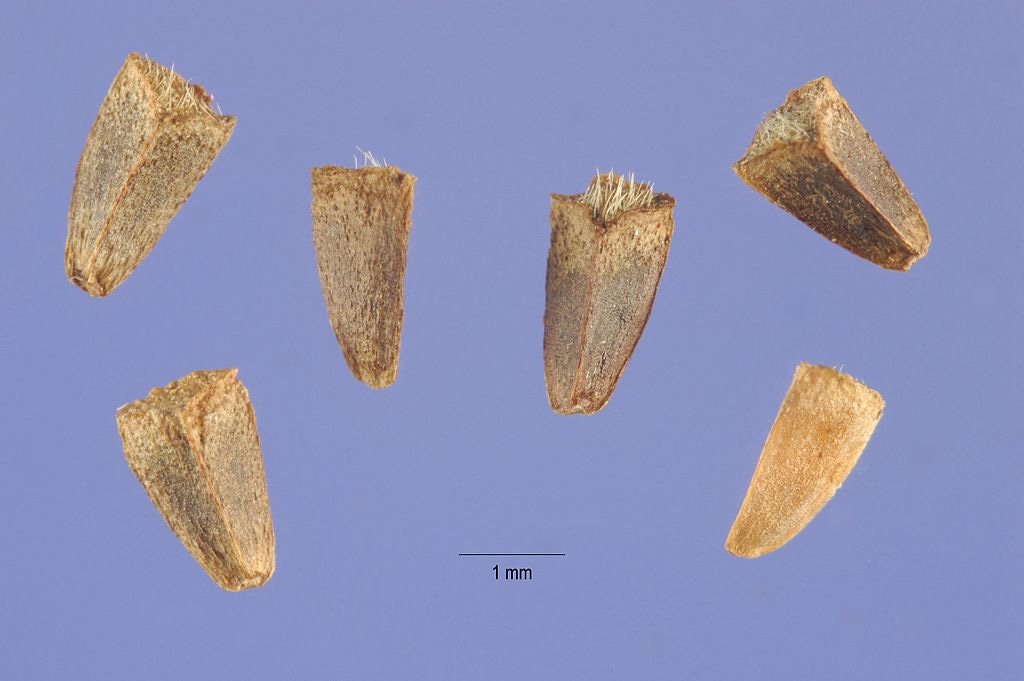
Archetypes
Fuzzy wuzzy was a bear…
Both the lion and bear evoke fascination among humans. These forces of nature are alluring (such darling cubs!) and terrifying at the same time. Lions radiate a majesty that bears lack. No manes. But the lumbering bear is somehow more relatable, more like the “people” that didn’t want to leave the woods. Perhaps its that they have a mouth full of sweet teeth. I can attest to this. They will ransack hummingbird feeders, bee hives, and remember the diaper.
I know, you were trying to forget.
Bears are known for their courage, especially those mothers of all mothers.
In fact, they might be more lion-hearted than lions.
Bears represent the seasons, sleeping through the dark days of winter, emerging with a penchant for stimulating foods, eating berries all summer, while innocently (or not) wreaking havoc.
Bear stories are just as exciting today as they were in ancient times. I know this because there seemed to be an ad-hoc telephone tree that formed every time a bear sighting occured in my home village. Now the reports are usually from cams and sent via text or social media.
(look at the cute bear destroying my hummingbird feeder)
Bears are in the genus Ursus, which relates to the word Ursa as in Ursa major and Ursa minor meaning Big Bear and Little Bear. Mostly we call those constellations the Big and Little Dippers.
But then there is the story of Callisto and her little bear. Callisto was seduced by the voracious Zeus and turned into a bear by Artemis. Zeus then placed Callisto among the stars calling her Big Bear, while their son became the little bear.
The brown bear is called Ursa arctos, which essentially means bear of the bears. Perhaps this bear was considered the Platonic bear. Here again is an association with Artemis, Artio (an obscure bear entity honored by the Celtic-Gauls) and perhaps even King Arthur.

Growing & Gathering
Motherwort is considered invasive by many, so not often planted intentionally, but it often shows up in gardens and other places where the soil has been disturbed. Surprisingly, I had a hard time finding one today. I wanted to have the plant in my hot little hands so I could smell and feel it while wrote the description of it.
Preparing & Preserving
If it shows up in your garden be sure you have the right plant because there are a couple of toxic to poisonous plants with similar leaves. Like buttercups, delphinium (larkspur), and wolf’s bane (aconite). Wait for the flowers to be sure you have the correct plant. The flowering seed stalk is what you want anyway.
The stalk will continue to make new flowers while the lower flowers fall away and the seeds form. I like to find a flower stalk with both mature seed pods and flowers. Some herbalists prefer to use the mature seed pods only.
But watch out, to take the bear metaphor one step further, the seeds are protected by a matrix of sharp points, like a mother bear’s claws protecting her young.
Use fresh, wilted, or dried in the healing preparations below. Or try all three to see how they differ - this is a great exercise in understanding the energetics of the final preparation.
Healing Preparations
“There is no better herb to take melancholy vapours from the heart, to strengthen it, and make a merry, chearful, blithe soul than this herb.”
~ Nicholas Culpeper
Motherwort Tincture or Glycerin Extract
To follow the folk (easy) method - fill a small jar with motherwort and cover with alcohol. If you want more precision, use a 1:1 ratio of 1 g. fresh plant material by weight in grams to volume of alcohol as milliliters. Or use a 1:5 ratio when using dry plant material.
Glycerins are a little harder because the final product needs to have 55% glycerin to be shelf stable. It’s easier using dried plant material with a little water (note that glycerin is not 100% glycerin, so this is where the maths come in). If you want to use fresh plant, I suggest wilting it overnight first to reduce the water content. Or do a test to calculate water content by weighing a piece of it fresh. Then dehydrating and weighing again. Then do the math to figure out how much you plant matter you will need.
Let the concoctions soak for a couple of weeks or so while shaking the jar a couple of times a day. No, this is not precise and does not need to be. Then strain your mixture and bottle in dark containers or keep in a dark cupboard. I usually put the plant material back in the garden or in the compost, with much gratitude. Be sure to label your preparations with names of the plant, date collected, moon phase if you like, and location collected, and ALL ingredients (for some reason my students often write all the plants on the label and then forget to add the ingredients they are infused in).
Motherwort Infused Oil
Visit my post on dandelion flowers for instructions on how to make an infused oil.
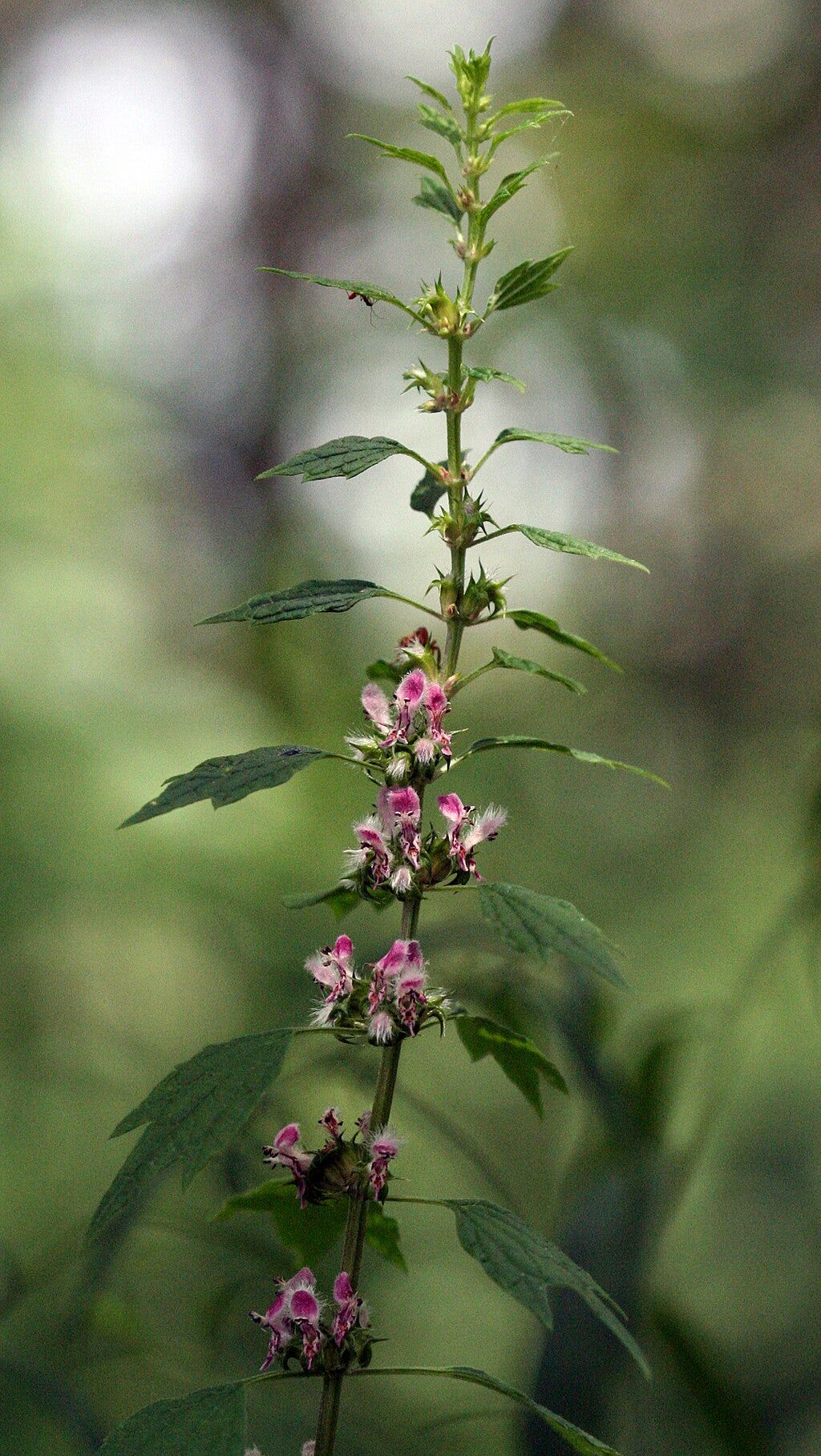
Materia medica
Element: Fire
Celestial Influence: Venus
Energetics: drying, cooling especially for the circulatory system, slightly warms digestion and the uterus
Taste(s): bitter, acrid, aromatic
Vital or Herbal Actions: relaxant, nervine, anti-inflammatory, analgesic, antispasmodic, emmenagogue, antipyretic (reduces fever but not by opening the pores like a diaphoretic)
Tissues or Organs Affected: tones and calms the circulatory system; stimulates uterine contractions; bitter tastes stimulate the liver and digestive organs
Used for: anxiety with heart palpitations; menstrual difficulties, perimenopausal, and menopausal symptoms such as cramping, anxiety, depression, bloating, stuck menses, heat flushing, night sweats, etc.; not recommended when there is heavy bleeding.
Scientific Knowledge (how it might work, chemical constituents, nutrients, etc.): if you are interested in phytochemistry, check out this review of research findings, just remember that when working with the whole plant that the energetics and herbal actions are more predictive of outcome than any singular chemical constituent.
How to Use: alcohol or glycerin extracts are most common; the tea can also be used, but if used as a standard infusion (1 quart water to 1 oz dried herb), it can be intensely bitter; infused oil topically for menstrual or other muscle cramps
Doses: drop doses of tincture (1-5 drops) work for most people because the of the intensely bitter taste.
Safety Category: motherwort is not on the FDAs “generally regarded as safe” list of herbs, due to the following contraindications and warnings.
Contraindications: motherwort is an emmenagogue, meaning it stimulates the uterus, so best to not use during pregnancy, while trying to conceive, or during heavy menses.
Warnings: May interact with cardiac medications. Research on thyroid effects is very limited, but the expectation is that motherwort extractives might help lower high/hyper thyroid.
Allies: mints and other aromatic plants to improve the taste
Adjuncts (herbs to use instead): mugwort or angelica for conditions related to menstruation, perimenopause, and menopause; skullcap, lemon balm, hawthorn for cardiac effects.
Antagonists: stimulants (having the opposite effect), demulcents (the tannins in motherwort might bind with the mucilage and precipitate into a disgusting goop ball at the bottom of your jar)
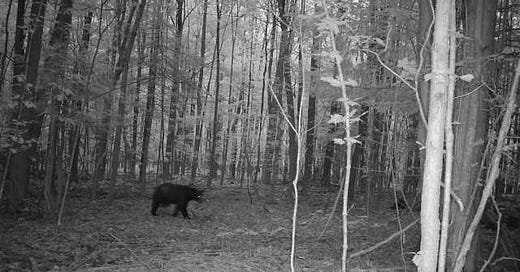



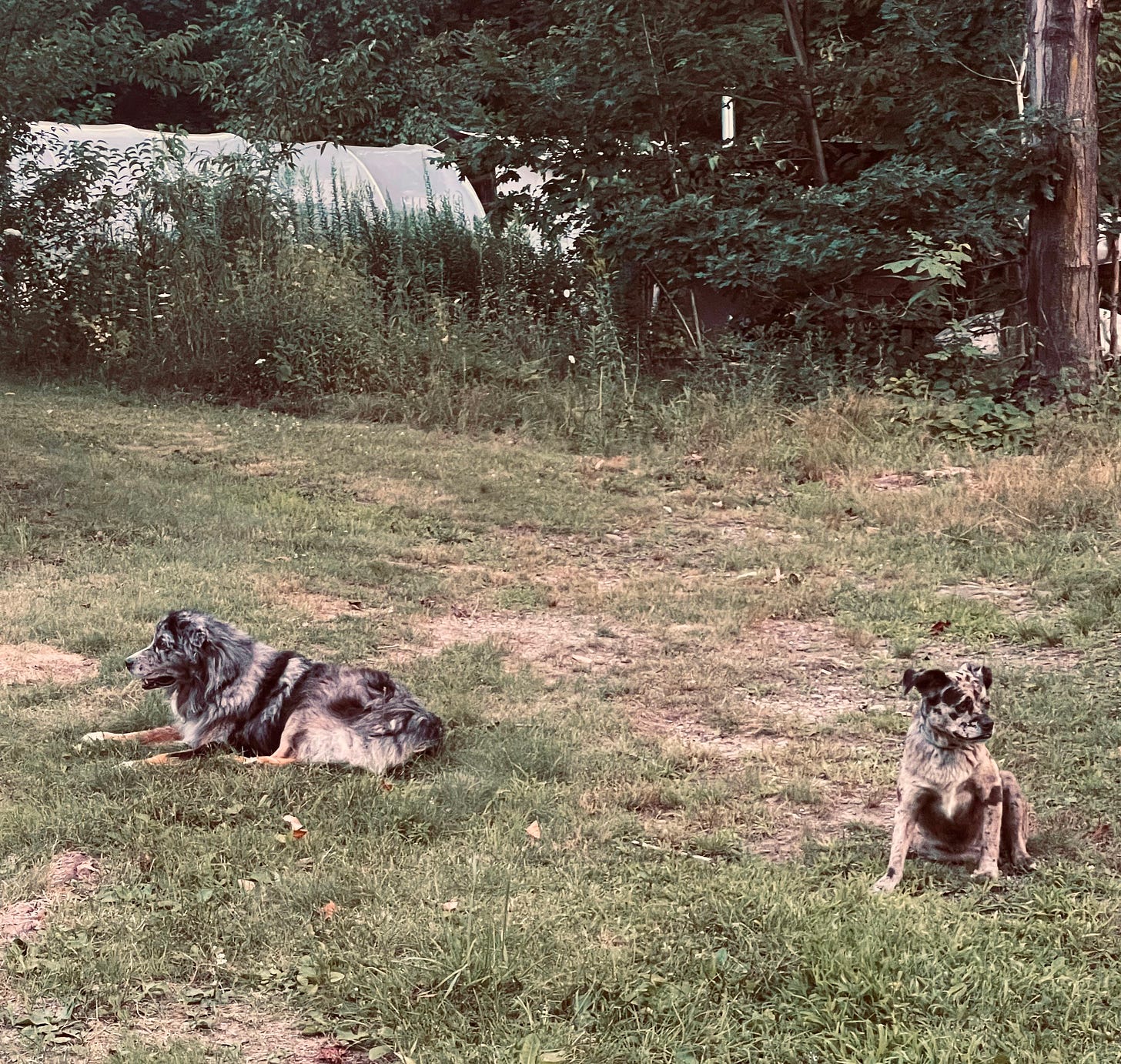
What a fantastic contribution to Bears and Bears and Bears, Oh My!, Leah. Thank you. We're delighted to have "Bear Sightings" as part of the collection.
That bear photo is soooo good. And how great that you took it the same day Paul posted his bear story.
Wonderful! I loved this whole story -- the form, your description of the bear encounters (the trio nodding, heading off to fish gave me such a wonderful image), learning about the story of bears as people who decided to live in the forest, the motherwort connection!
Thank you, Leah.
I'm one of the Caravan Writers Collective folx with Paul, and what an absolute delight to see this contribution for our bear stories collection and to "meet" you.
PS. The photos are terrific too, the bear and those dogs are just gorgeous. Big squirrel!! 😆♥️♥️♥️